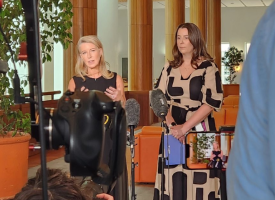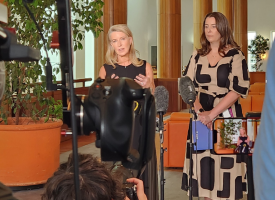Public hospitals in decline nationally
AMA Public Hospital Report Card 2009
AMA President, Dr Andrew Pesce, said today that Australia’s public hospitals continue to be seriously under-funded and are struggling to meet growing public demand for their services.
The AMA Public Hospital Report Card 2009 is an analysis of the most up-to-date national data on public hospital performance plus more recent feedback from doctors working in public hospitals in all States and Territories – and the results aren’t good.
Dr Pesce said the report shows that the public hospital system is continuing to decline and, despite the best efforts of a dedicated and hardworking health workforce, quality and safety are being put to the test.
“Patient care is being compromised by access block in emergency departments, with far too many patients waiting more than eight hours in emergency to be admitted to a hospital bed,” Dr Pesce said.
“We need to ensure a maximum 85 per cent bed occupancy in public hospitals so that patients who need a bed can get one and patients who need elective surgery can have it in an acceptable timeframe.
“Waiting times for elective surgery are the longest they have ever been because our public hospitals just don’t have the capacity to cope with demand and meet performance targets.
“The extra Federal funding made available from January 2008 for the elective surgery ‘blitz’ appears to have made little short or medium term difference to the waiting lists.
“One of the key findings of our report is the new phenomenon of hidden waiting lists of people waiting to get on the waiting lists for elective surgery.
“This is the situation where people needing elective surgery aren’t actually counted on the waiting list until they have their first appointment with a public hospital specialist.
“While the official data show that in the larger States around three quarters of elective surgery patients are seen within the recommended time, our doctors tell us that, in reality, people are waiting much longer to access elective surgery.
“The AMA does not think it is helpful or appropriate to manipulate this important information to make it appear that hospitals are performing better than they really are.
“To enable us to get a more accurate assessment of how new funding is affecting waiting lists, we need a nationally consistent and transparent reporting system that provides clear and accurate information about the number of people on waiting lists, and the number of elective surgeries performed.
“Overall, our public hospitals are seriously under-resourced, which is unacceptable. This is very much due to the ‘blame game’ over hospital funding between the Commonwealth and State Governments.
“The AMA believes the time has come for a single public funder for public hospitals – one level of government that has total responsibility for fully funding the public hospital system.
“We are not suggesting a Commonwealth takeover of the operation or ownership of public hospitals.
“Instead, the AMA supports a single funding source that is fully accountable for providing sufficient funding for the public hospitals, while retaining local governance arrangements.”
Key findings of the AMA Public Hospital Report Card 2009 include:
- The National Healthcare Agreement signed by governments in late 2008 set a target that, by 2013, 80 per cent of emergency department presentations would be seen within the clinically recommended time of less than 30 minutes. Right across Australia, public hospitals have huge ground to make up in order to meet that target. The national average is down at 60 per cent, well short of the current target of 70 per cent. No State or Territory is anywhere close to meeting the current target of 70 per cent, let alone the target of 80 per cent by 2013,
- Access block in emergency departments is a serious problem, with the most recent Australasian College for Emergency Medicine (ACEM) survey showing that 70 per cent of patients waited more than eight hours for a bed. ACEM has set a target of 10 per cent or fewer patients waiting more than eight hours in emergency departments for admission to hospital. Access block in emergency departments should be formally monitored against this performance benchmark,
- To ensure that safe and quality care can be provided to patients, every public hospital must have the capacity to operate on an average bed occupancy rate of 85 per cent. There must be public reporting of the number of available beds for each public hospital and the occupancy rates,
- Public hospitals are the traditional training ground for medical school graduates. Interns are the backbone of public hospitals. By ensuring there are sufficient training places for the increase in medical graduates over the next few years, State and Territory governments would also be ensuring they can meet future medical workforce needs.
Dr Pesce said the AMA Report Card is being released as the Federal Government contemplates a huge health reform agenda.
“It would be a grave mistake for governments to think that reform is simply about the hospital system doing more with less,” Dr Pesce said.
“Our public hospitals need more beds, more doctors, more nurses, and more infrastructure – and they need all these things now, not at some politically opportune time in the future.
“The Australian people will continue to hold all governments accountable for ensuring that public hospitals have sufficient capacity to meet the demands for their services.
“The Australian people rightly expect public hospitals to be resourced to meet community needs – their needs, and the needs of their families, friends and loved ones.”
Summary of Key Findings – by State and Territory
In terms of emergency department waiting times, the current performance benchmark is 70 per cent and the National Healthcare Agreement target by 2013 is 80 per cent of emergency department presentations seen within clinically recommended triage times.
In terms of elective surgery waiting time, the AMA’s national target is that at least 90 per cent of elective surgery patients should receive their surgery within recommended times.
The data below shows that no State or Territory is achieving these targets and, indeed, the performance of most States and Territories is getting worse across hospital performance measures, not better.
New South Wales
Emergency department performance – down. Only 66% of category 3 (urgent) emergency department patients are seen within the recommended time - compared to 71% in 2006-07.
Percentage of category 2 elective surgery patients seen within 90 days – up by only 1%. 75% of patients are seen within the recommended time - compared to 74% in 2006-07.
Elective surgery waiting time – longer. Median waiting time for elective surgery is 39 days – up from 35 days in 2006-07.
Victoria
Emergency department performance – down. Only 68% of category 3 (urgent) emergency departments patients are seen within the recommended time – compared to 73% in 2006-07.
Percentage of category 2 elective surgery patients seen within 90 days – down by 5%. 70% of patients are seen within the recommended time - compared to 75% in 2006-07.
Elective surgery waiting time – longer. Median waiting time for elective surgery is 33 days – up from 30 days in 2006-07.
Queensland
Emergency department performance – down. Only 54% of category 3 (urgent) emergency department patients are seen within the recommended time - compared to 57% in 2006-07.
Percentage of category 2 elective surgery patients seen within 90 days – up by only 1%. 83% of patients are seen within the recommended time - compared to 82% in 2006-07.
Elective surgery waiting time – longer. Median waiting time for elective surgery is 27 days – up from 25 days in 2006-07.
Western Australia
Emergency department performance – down. Only 49% of category 3 (urgent) emergency department patients are seen within the recommended time - compared to 59% in 2006-07.
Percentage of category 2 elective surgery patients seen within 90 days – up by 3%. 70% of patients are seen within the recommended time - compared to 67% in 2006-07.
Elective surgery waiting time – longer. Median waiting time for elective surgery is 30 days – up from 29 days in 2006-07.
South Australia
Emergency department performance – down. Only 54% of category 3 (urgent) emergency department patients are seen within the recommended time - compared to 56% in 2006-07.
Percentage of category 2 elective surgery patients seen within 90 days – down by 5%. 73% of patients are seen within the recommended time - compared to 78% in 2006-07.
Elective surgery waiting time – longer. Median waiting time for elective surgery is 42 days – up from 40 days in 2006-07.
Tasmania
Emergency department performance – down. Only 42% of category 3 (urgent) emergency department patients are seen within the recommended time - compared to 62% in 2006-07.
Percentage of category 2 elective surgery patients seen within 90 days – down by 5%. 49% of patients are seen within the recommended time - compared to 54% in 2006-07.
Elective surgery waiting time – shorter. Median waiting time for elective surgery is 36 days – down from 38 days in 2006-07.
Australian Capital Territory
Emergency department performance – up. 51% of category 3 (urgent) emergency department patients were seen within the recommended time - compared to 47% in 2006-07.
Percentage of category 2 elective surgery patients seen within 90 days – down by 4%. 47% of patients are seen within the recommended time - compared to 51% in 2006-07.
Elective surgery waiting time – longer. Median waiting time for elective surgery is 72 days – up from 63 days in 2006-07.
Northern Territory
Emergency department performance – down. Only 43% of category 3 (urgent) emergency department patients are seen within the recommended time - compared to 54% in 2006-07.
Percentage of category 2 elective surgery patients seen within 90 days – up by only 1%. 59% of patients are seen within the recommended time - compared to 58% in 2006-07.
Elective surgery waiting time – longer. Median waiting time for elective surgery is 43 days – up from 35 days in 2006-07.
AMA Priority Investment Plan for Australia’s Health System
Last month, the AMA released its Priority Investment Plan for Australia’s Health System – a plan for immediate action to fix the health system.
The plan – available here – sets out some important and practical recommendations to support Australia’s public hospitals.
The AMA plan for our public hospitals involves:
- Undertaking a stocktake of the actual number of beds needed in each hospital to ensure no more than 85 per cent average occupancy;
- Undertaking a stocktake of the number of sub-acute beds needed to take pressure off acute hospitals in each area;
- Obtaining formal intergovernmental agreement on the timeframe for their establishment and formal agreement of the evidence that will be provided to demonstrate that the States have also provided the additional required funding in each institution’s recurrent budget;
- Implementing a robust accountability system so that the Commonwealth can be assured unequivocally that the funding it is providing under the new National Healthcare Agreements is used to establish these new beds within agreed timeframes - say, within the next 18 months; and
- Implementing an ongoing monitoring system – Bed Watch – that would transparently report on the number of new and existing beds that are available in public hospitals. Bed Watch would also monitor other important factors related to hospital occupancy such as access block in emergency departments, with a view to achieving a target of 10 per cent or fewer patients who wait more than eight hours in emergency departments before reaching an inpatient bed or being transferred to another hospital for admission.
14 October 2009
CONTACT:
John Flannery 02 6270 5477 / 0419 494 761
Peter Jean 02 6270 5464 / 0427 209 753



